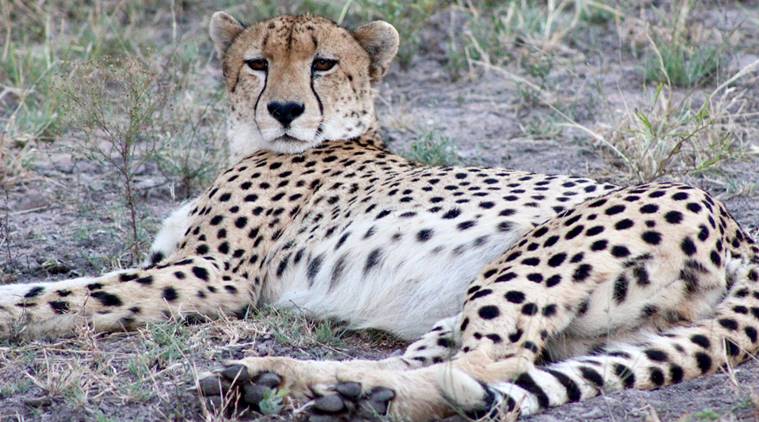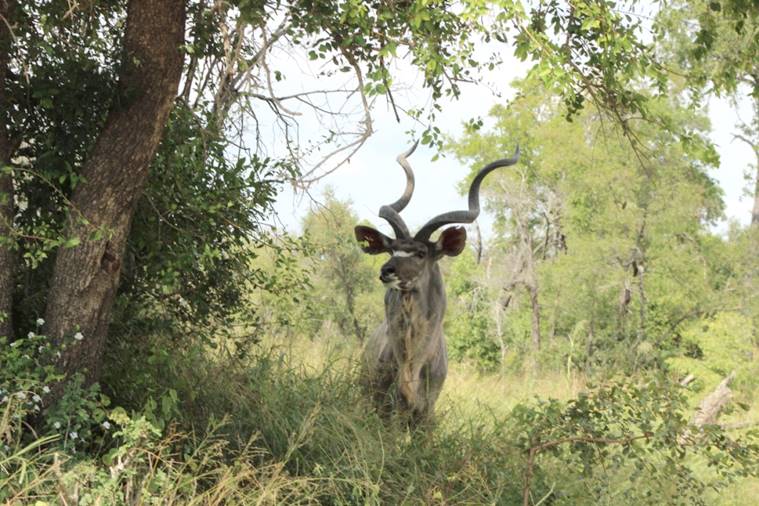
It was the first week of April and the bush was still thick from the summer rains as we drove in a game viewer through the bumpy red-sand track of the Sabi Sands Private Reserve. Conrad, our 25-year-old guide for the next 14 hours, picked us up from Kruger’s Skukuza airport, an upscale shack in the South African bushveld.
On our way to the Sabi Sabi Earth Lodge, Conrad told us that it was the beginning of the dry season and not the best time for game viewing. My face fell. Then I remembered a mahout’s words from two decades ago on a winter morning in India’s Jim Corbett National Park. On sensing my frustration at not spotting a tiger, he had said, “See beauty in the dew drops on the leaves and enjoy the experience atop the elephant.”
The Sabi Sands Game Reserve, which gets its name from the two rivers, Sabie and Sand, is 65,000-hectare private preservation area adjoining the 30 times larger Kruger National Park. While Kruger National Park is open to the general public, Sabi Sands admits access to only those with a reservation in one of its lodges to view the 70 species of mammals, 300 types of birds, and 57 kinds of reptiles found within its precincts. Unlike Kruger, Sabi Sands allows its rangers to go off track in search of the Big Five (lion, leopard, rhino, elephant, buffalo) that move freely between the unfenced bushes of the two reserves.

Conrad arrived at our lodge in an open game-viewing vehicle for the evening safari with Richard — our middle-aged, six-foot tracker, from the Shangaan tribe — whom Conrad introduced as his eyes and ears. His neck moved so swiftly to scan the bush, it was hard to keep pace with it.
A few minutes into the drive, Richard pointed to a male waterbuck. Conrad said the hunters avoid killing this African antelope because of its oily skin. “It’s hard to skin it without getting its hair on one’s hands and contaminating the meat in the process,” he explained. Sensing our presence, the ringed-horn creature bounced out of sight. Orange and black-spotted garden acraeas fluttered in front of our vehicle and on the right, African monarchs rested on purple paintbrush plants. Suddenly, an excited voice boomed through the radio and Conrad turned the steering in the opposite direction. Another ranger had tipped him off about a rare sighting. “It’s a surprise,” he screamed, rushing past an elephant on the dirt road.
Conrad’s surprise — one of the three cheetahs in Sabi Sands — sat flicking his ears and tail on a grassy patch, chasing flies away. We learned he had killed a waterbuck two days ago and was ready to attack again. It would have been a magnificent sight to see him sprint towards a gazelle or a hare. But all he did was roll on his back, walk leisurely, and mark his territory on a tree trunk to catch the whiff of a female.
As temperatures dropped, we drove back on the lovegrass track. The whistles of the fiery-necked nightjars and the sound of crickets filled the bush, leaves rustled as a bush baby jumped trees, and a chameleon slept unperturbed on a russet bushwillow. We, too, were ready to hit the sack.

Next morning, the sun shone on a leopard’s footprints — that’s all we got of the big cat. We stopped to catch a glimpse of zebras as Conrad gave gory details of male zebras biting off each other’s tails. Richard pointed to a half-hidden rhinoceros sitting in the tall grass on the opposite side. It stood up with a red-billed oxpecker on its back and what we saw left us angry and sad. The animal had injury marks that Conrad suspected were from an unsuccessful attack by poachers (most of whom come from Mozambique, which shares a porous border with Kruger). Every year in Kruger, roughly 700 rhinos are killed for their horns.
On a nearby tree, a green wood hoopoe laughed. The radio screamed, cutting through our silence. Conrad zoomed off, and, minutes later, we were really close to a pride of lions. A lioness and her four cubs were napping on the road separating Sabi Sabi and the Mala Mala reserve. The leader of the Mala Mala’s Sparta pride was injured after a face-off with the Mhangeni pride of the Singita Sabi Sand game reserve, we were informed. Conrad said, Sparta is believed to be a breakaway group of Sabi Sabi’s southern pride. Being a big group of 18 lions, it was always in conflict over meat and authority, and so some of them deflected and ended up in Mala Mala’s territory.
That evening was our last safari in Sabi Sabi and we wanted to make the most of this four-hour ride. We drove down from our lodge to a little pond at its base to see the resident hippopotamus. Conrad parked the vehicle far from the pond. Hippos can charge at a speed of 30 miles per hour and have earned a reputation of being Africa’s most dangerous large mammals. Conrad said the creatures are found submerged or lazing by waterbodies because their skin is sensitive to the sun and desiccation. They secrete a reddish fluid called “blood sweat” that acts as a moisturiser, sunscreen, and antibiotic. Good they aren’t amiable beings lest the cosmetic industry would have patted them dry.
A hippo’s temperament and a safari experience have something in common. They are both unpredictable. Ours took a sudden turn as we heard about a leopard sighting in the east. We drove up the hill, crossed a herd of elephants led by a 40-something-old matriarch, and reached a grassy clearing. The half-hidden leopard, sensing the approaching shutterbugs stood up, and posed under a jackalberry tree before sauntering off, past a dry pond and a willow tree into the higher bush. The loud haa-haa-haa-de-dah of a hidden hadeda ibis replaced the solitary animal’s presence, and, as we left the cacophony behind, we saw through a curtain of yellow thatching grass, a herd of Cape buffaloes chewing on fever grass and grunting, unaware of the predator lurking around. I don’t know about the buffaloes, but with this final Big Five viewing, we had finished our main course.